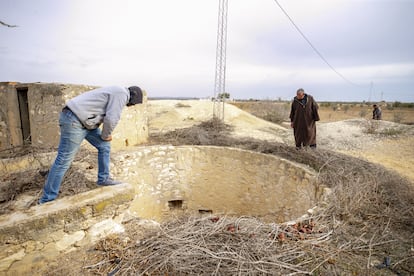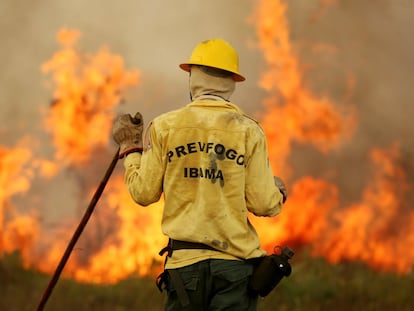‘Flash’ droughts are besieging the planet
Climate change has been producing more dry spells at a faster rate over the past 70 years

In The Grapes of Wrath, John Steinbeck tells the dramatic story of a family from Oklahoma forced to abandon their drought-stricken farm. Steinbeck’s novel was made into a film directed by John Ford and starring Henry Fonda. The tale of Tom Joad and his family is based on true events in the mid-1930s, when several years of extreme drought turned the American central plains — one of the world’s great granaries — into a dust bowl. In 2012, almost 80 years later, farmers in that area were expecting a bountiful harvest. But several days after the cornfields were planted in May, a sudden drought wiped out their crops within a few weeks. In less than two months, 76% of the crops were affected and losses topped $30 billion. The region’s water deficit even surpassed the drought described by Steinbeck. A recent study shows that these “flash” droughts are becoming widespread almost everywhere in the world due to accelerating climate change.
The 2012 event in the United States put the spotlight on flash droughts, but the concept first appeared in scientific journals 10 years earlier. The world has always had droughts — what’s different now is their speed and intensity. A conventional drought slowly develops during months or years of below-average precipitation. Flash droughts spring up suddenly and peak in a matter of weeks or days, and lack of rainfall is not their only cause. A fluctuating process of moisture exchange is always happening between the soil (and vegetation) and the atmosphere. Under normal conditions, rain falls on soil and vegetation, which hydrates the air through soil evaporation and leaf transpiration (evapotranspiration). But even when it doesn’t rain, the atmosphere continues to draw water from the earth’s surface. This can trigger a sudden drought if a heat wave or dry winds spring up in a place where it hasn’t rained for a while.
A group of Chinese and U.S. researchers analyzed data since 1951 to identify the development and distribution of flash droughts. The study published in Science shows an upward trend of these events, both in terms of geographical distribution and frequency. Flash droughts are occurring more often in the planet’s humid regions: Canada, Siberia, the Gulf of Guinea (West Africa), the Amazon rainforest, Indonesia, Papua New Guinea, and the jungles of Southeast Asia. Flash droughts in these areas can be three times more frequent than in the rest of the world.
Still, it’s a global problem that’s getting worse. Excluding the two poles, flash droughts are now more frequent in 74% of the planet for several reasons: less rainfall, higher temperatures, and intense heat waves that happen more often and last longer. Hydrological and flash droughts also still occur in typical areas like the Sahel and Maghreb in Africa, northern Australia, eastern and central Mexico, eastern Asia, and so on.
The onset rate has risen sharply because of climate change, resulting in a global transition to flash droughtsXing Yuan, Nanjing University, China
Xing Yuan, the dean of Nanjing University’s School of Hydrology in China, led the study published in Science. “Drought used to develop slowly, but the onset rate has risen sharply because of climate change, resulting in a global transition to flash droughts,” he says. More intense and rapid droughts bring new impacts. “Vegetation may have less time to adapt to rapid onset droughts. They also pose a major challenge to early warning systems — we don’t have enough time to prepare for a flash drought.”
David Walker, a drought researcher at Wageningen University in the Netherlands, says, “it makes sense that, with warmer temperatures caused by climate change, we will have higher evapotranspiration, so we can expect more droughts.” But, Walker adds, “Xing Yuan’s work shows us that besides having more droughts, they will also emerge faster. This is already happening.”
Regarding their geographical distribution, Walker notes that “a drought only matters when it affects a society, economy and/or environment.” Even if flash droughts are happening more often in wet regions, they are better able to cope. “The threat, or risk, is probably greater in arid and semi-arid regions that have less water available for supplemental irrigation and suffer more from land degradation. In addition, many of them are poorer countries with additional challenges like political instability and conflict,” said Walker.
The risk is greater in arid and semi-arid regions that have less waterDavid Walker, drought expert at Wageningen University, the Netherlands
A study published in 2021 reached similar conclusions. It also analyzed flash droughts (starting with data from 1980), but focused on their distribution in large agricultural areas. The study concluded that the impact of flash droughts was global: the US Corn Belt; the vast expanses of wheat in southwestern Russia and Ukraine; the rice farms of India and Indochina; the millet and sorghum of the Sahel; and the barley fields of Spain, the world’s third largest producer.
Jordan Christian, a meteorologist with the University of Oklahoma and a coauthor of the 2021 study, said, “Flash droughts have the same impacts as conventional droughts that develop slowly, such as declining agricultural yields, impacts on livestock, stress on ecosystems, etc. — but at a much faster rate. This creates challenges for early warning systems and shortens response times for mitigation strategies.” The 2012 event in the United States showed that a flash drought in May doesn’t have the same impact as one in October.
What we are experiencing in Spain is not a flash drought – it’s hydrological – caused by a prolonged precipitation deficitSergio Vicente Serrano, Pyrenean Institute of Ecology
Sergio Vicente Serrano, a scientist with the Pyrenean Institute of Ecology (IPE-CSIC), said “What we are experiencing in Spain is not a flash drought — it’s hydrological — caused by a prolonged precipitation deficit. But in May 2022, we had a heat wave that destroyed 25% of the grain crop.” Vicente helped create the Flash Drought Monitor and published a paper on flash droughts in 2020, focusing on the Iberian Peninsula and the Balearic Islands. Similar to the other studies, Vincente and his colleagues found that the frequency of flash droughts was higher in the humid regions of north and northwest Spain. However, they did not identify a clear upward trend in frequency, “except in the center and south, particularly in summer.”
Like many other scientists, Vicente points to global warming as the cause of the increased frequency of flash droughts. “Over the last 60 years,” he said, “the average annual atmospheric [moisture] demand per square meter has risen from 1,100 liters in 1961 to 1,200 liters today. Without those 1,200 liters on the ground, soil, plants, crops all get stressed.”
Sign up for our weekly newsletter to get more English-language news coverage from EL PAÍS USA Edition
Tu suscripción se está usando en otro dispositivo
¿Quieres añadir otro usuario a tu suscripción?
Si continúas leyendo en este dispositivo, no se podrá leer en el otro.
FlechaTu suscripción se está usando en otro dispositivo y solo puedes acceder a EL PAÍS desde un dispositivo a la vez.
Si quieres compartir tu cuenta, cambia tu suscripción a la modalidad Premium, así podrás añadir otro usuario. Cada uno accederá con su propia cuenta de email, lo que os permitirá personalizar vuestra experiencia en EL PAÍS.
¿Tienes una suscripción de empresa? Accede aquí para contratar más cuentas.
En el caso de no saber quién está usando tu cuenta, te recomendamos cambiar tu contraseña aquí.
Si decides continuar compartiendo tu cuenta, este mensaje se mostrará en tu dispositivo y en el de la otra persona que está usando tu cuenta de forma indefinida, afectando a tu experiencia de lectura. Puedes consultar aquí los términos y condiciones de la suscripción digital.
More information
Últimas noticias
NASA discovers Titan doesn’t have an ocean, but a ‘slushy ice layer’ that increases possibility of life
Innocence lost in the forest of the child soldiers: ‘Each leader of the armed group had his girls’
‘Fallout’ or how the world’s largest company turned an anti-capitalist apocalyptic Western into a phenomenon
From inflation to defending migrants: Eileen Higgins and Zohran Mamdani inaugurate the new Democratic resistance against Trump
Most viewed
- ‘El Limones’ and the growing union disguise of Mexican organized crime
- Christian Louboutin: ‘Young people don’t want to be like their parents. And if their parents wear sneakers, they’re going to look for something else’
- The low-cost creative revolution: How technology is making art accessible to everyone
- ‘We are dying’: Cuba sinks into a health crisis amid medicine shortages and misdiagnosis
- A mountaineer, accused of manslaughter for the death of his partner during a climb: He silenced his phone and refused a helicopter rescue











































